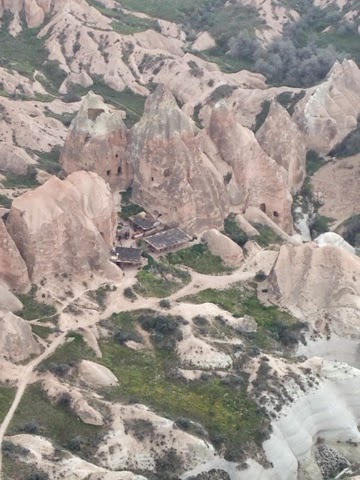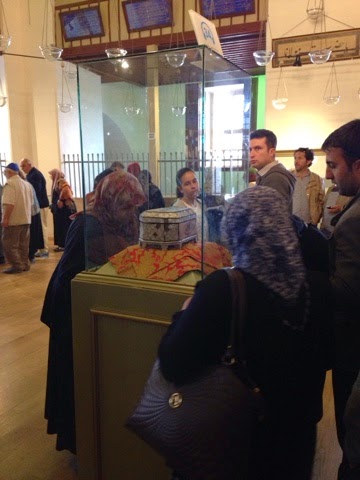From the breakfast station a few miles from the take off point. Ours wasn't as pretty, but who cares! These are!
Takeoff! For other people...
Our basket could hold 24 people, plus 2 pilots. Just look and see how tall the balloon is in relation to our height!
This mountain, Mount Erciyes at about 3900 meters tall, is the volcano that created all the volcanic rock formations about 20 million years ago.
Remember the pottery shop town from yesterday? How about from several thousand feet up?
I think I'll let the natural beauty speak for itself...
And a group picture for good measure.
...
When Silk Road traders (moving from southern Europe, through Central Turkey, north through Central Asia, the Asian Steppe, then to China), they were forced to stop for the evenings. In order to protect the expensive cargo they were carrying (silks and porcelain from China and silver to pay for it), the traders made their best effort to find "caravan surai" like this one. If these large fortified buildings were built by the government, traders could stay in the surai for the night for no charge, just like a hotel would be (privately owned surais and staying more than one night would warrant a charge). This particular surai was built in 1220 AD, sponsored by Keykubat, leader of the Seljuk people prior to the Ottoman Empire.
The massive, beautiful gate at the front of the surai served three purposes. First, the high gates allowed camel drawn wagons to enter without hitting their heads and ruining the cargo. Also, guards would stand watch at the gate, making sure that no looters, very common to the area around the Silk Road all the way to China, were allowed in. Finally, the ornate carving work above the gate shows how powerful the leader is and how strong the communities were.
At the center of the surai was a Muslim prayer center (though none for other religions), as the government at the time were all Islamic. Prayer occured on the second floor, a 16 by 16 square with a Mihrab wall facing Mecca.
The rooms on the left hand side were the "hotel rooms" for the surai where the caravan leaders slept in the wintertime. If the weather was warm, they could also sleep in the open air market (see below!)
This is the open air market, as promised. Here, local merchants could come into the surai and sell their local products and assist in repairing the wagons, including horseshoe repair for the camels. This also kickstarted the local economy, providing more opportunities for work for the locals.
The rear of the building is where the camels, merchandise, and their security officials slept and made repairs. Notice how high and long this room is, allowing ample room for many, many wagons.
...
Human beings have not always been living in towns and cities forever, neither have they always relied on farmers to provide their produce and vegetables. Instead, people relied on the men's abikity to hunt wild game and the women's ability to gather small fruits and vegetables from wild plants, known as hunter and gatherer societies (Paleolithic Age). Around 7000 BC, a change occurred where people began to settle in one place and begin farming on an experimental basis in a city named Catalhoyuk. Here is our experience.
The whole of the city is located on a rather large hill covering 32 acres. There are two active archeological sites on the property (one is under the white tent), and the digging season begins on June 1st and ends around the end of August.
The view from inside the tent! Just a massive hole full of history!
Another recreation of what a Catalhoyuk home would have looked like more than 8000 years ago. These people seemed to be very clean, as they frequently whitewashed their walls in their homes, sometimes up to 450 times! Also, there is an opening in the wall behind Sara which is the entrance to three small rooms, where the family would store their food and supplies. Also, these families used the furs of local animals they had hunted for cushions and blankets for their homes.
One of the homes in the north dig site. Notice that the wall in the back left near the plants is a wall that would immediately lead to another house without any gaps. Without fortification walls, this protects the city from invasion. Most interestingly, these people entered their homes from the roof for the same reason.
This dig site has two holes in the back of the home. This is the place where these people would bury their dead within their homes for reasons that are unknown. Before they were placed in their shallow graves, their surviving family members would place their family member in a pile for the local vultures to eat, then place the bones in the open holes. It seems gross and inhumane, but it is rather cleanly (as they probably knew).
When archeologists starts digs, they use sandbags to protect the hole from collapse and protect any treasures beneath the surface.
Another gorgeous view of another dig site on the property. When the archeologists start digging, they carefully dig out the layers one by one, usually about an inch deep, then record everything they find, including photographs, drawings, measurements, and careful extractions. Some holes, like in the foreground, require more support to hold the walls up, preventing collapse and injury.
During the dig season, a Catalhoyuk house would look like this quite often, with many people working on various areas all at the same time. Heidi offers a course every other Term III teaching how this process works, including working at a real site at Quarry Farm looking for Mark Twain memerobilia!
Domesticated sheep roam these hills every day from local farms around the area. Professional shepards are hired by the farmers. If you notice, each sheep is painted with a different color, signifying each different local family, so they can be returned each night.
...
This shrine located in Konya is dedicated to Rumi, a famous poet whose father was a Persian professor of Islamic law, before moving the family to Konya to escape the invading Mongols from the east in the early 1700s. As he grew up, Rumi learned the power of the pen, developing his own style of poetry. As a result, he gained a following of liberal Muslims in the region, claiming that living a simple life free of unnecessary lavishes is the only way to reach salvation in this life with God. However, the only real way to reach salvation is to pass away and become one with God in the afterlife. As a result of his teachings, he became the father of the monastic system in liberal Muslim life, a code that is still followed to this day. He is buried in the traditional Muslim way beneath the green dome, as green is the holy color of Islam, symbolizing Mohammed's army some 1400 years ago.
This structure was once used as a school for religious education classes. This whole complex was a combination of a school, shrine, mausoleum, and prayer center.
This is Rumi's tomb, buried in the traditional way, on his side facing toward the fabulous Mihrab wall toward Mecca. Those tiles are to die for!!!
In this ivory box is an actual hair from Mohammed's beard after he passed away. Though the hair is likely disintegrated by now, modern Muslims find healing power from smelling the inside of the box.
These "whirling dervish" dancers devised their art from Rumi's poems and teachings. In these dances, men raise their right hand to their God and their left hand to the earth and begin to spin, sending God's spirit into the earth. This dance symbolizes all of the earth's cycles:, water, days, season, life, etc.
AND NOW FOR THE HIGHLIGHTS! Boy did we have a great day!
Andrew: Instead of Snakes on a Plane, imagine Needles on a Balloon. It's the next horror movie!
Heidi slaps Michalis on the head for making fun of Liz on the bus and tells him to stop. After Heidi left the bus, he imitated her by showing us all his Heidi face, the ragging rabid dog with a hilarious growl.
For some reason, a random song of Old McDonald broke out with all the lovely animals we have shouted at while on the bus: SHEEP, GEESE, GOAT!
And a big thank you to Molly for her presentation on Catalhoyuk. Great job!



































































